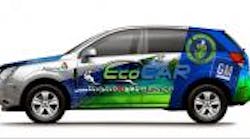“Our partnership with EPA will help us to develop and nurture science and engineering talent with real-world training and experience, allowing these engineering graduates to transition more rapidly into careers in the green vehicle industry.” –Patrick Davis, the U.S. Department of Energy’s vehicle technologies program manager, on the addition of the Environmental Protection Agency to the EcoCAR consortium
One of the important things going on largely behind the scenes in the realm of vehicle research is an effort by various government agencies – notably the Department of Energy (DOE) and the Environmental Protection Agency (EPA) – and manufacturers, like General Motors, to spur innovation.
And what better way to do than hold a nationwide contest pitting research teams made of university students and professors from the U.S. and Canada against one another? It’s a classic form of “friendly competition” that fires up imaginations, unleashes the drive to win, yet in the end benefits everyone involved – especially the environment, where new designs and technological paths can help further lessen the impact of motorized vehicles.
The EcoCAR Challenge is one such event, sponsored by DOE (and the EPA as well now) along with GM that challenges 17 universities across the U.S. and Canada to redesign and reengineer a 2009 Saturn VUE (a small SUV now sadly on its way to extinction) to minimize fuel consumption and reduce emissions. It’s a competition that – in the words of Margo Oge, EPA’s director of the office of transportation and air quality – is designed to “inspire” the next generation of automotive scientists and engineers.
[Here’s a look at the teams on “Day One” of this year’s EcoCAR event.]
Oge’s office provided technical advice and mentoring in the areas of greenhouse gas and tailpipe emissions for this year’s “EcoCAR event” and also conducted dynamometer emissions testing on the competition vehicles at the EPA’s National Vehicle and Fuel Emissions Laboratory in Ann Arbor, Michigan. GM provides vehicles, vehicle components, seed money, technical mentoring and operational support, while the DOE and its research and development facility, Argonne National Laboratory, provides competition management, team evaluation and technical and logistical support.
The Ohio State University (at left) earned top honors at the 2009 finals held in Toronto, Canada, this year – beating out 17 EcoCAR university teams with an Extended Range Electric Vehicle (EREV) powered by a 1.8 liter engine and fueled by E85 ethanol – a blended fuel comprised of 85% ethanol and 15% gasoline.
The second place vehicle design, engineered by students at Canada’s University of Victoria in Toronto, also was an EREV operating on E85 ethanol, while Mississippi State University snagged third place for its EREV model, powered by B20 – a blend of 20% biodiesel fuel, made from soybeans, and 80% regular petroleum diesel.
[Here’s a look at “Day Four” of the EcoCAR challenge.]
One of the reasons government agencies like the DOE are getting involved in such efforts like EcoCAR is that they know innovation can’t be manufactured on an assembly line. Patrick Davis, DOE’s vehicle technologies program manager, noted that innovation gets back to the concept of the “backyard garage,” where human minds tinker and toy with all sorts of possibilities.
Apple, for example, got its start in a Los Altos garage where the now-famous Steven Jobs and lesser known Steve Wozniak tinkered with their new computer prototype. Stanford University classmates Bill Hewlett and Dave Packard built HP's first product in a Palo Alto garage in 1939. And, more recently, Google founders Larry Page and Sergey Brin forever changed the Internet in a Menlo Park garage.
The garage, in Davis’ view, is an icon of innovation, emblematic of a spirit of invention that gives us hope that together any challenge can be overcome.
[Davis shares more of his insight on the DOE’s work with the EcoCAR challenge in the clip below.]
Hopefully, despite the troubled economic times we’re living through, competitions like the “EcoCAR challenge” can keep going, for at some point, hopefully, they just might produce a silver bullet of sorts to solve the fuel consumption and emission hurdles all motor vehicles face today.





